Electron Impact Ionization and Partial Ionization Cross Sections of Plasma-Relevant SiClx (x = 1–3) Molecules
Abstract
1. Introduction
2. Methodology
2.1. Ionization Cross Sections: The BEB Model
2.2. Partial Ionization Cross Sections: The Modified BEB Model
3. Computational Details
3.1. Clorosilylidyne (SiCl)
3.2. Dichlorosilylene (SiCl2)
3.3. Trichlorosilyl (SiCl3)
4. Conclusions
Author Contributions
Funding
Data Availability Statement
Acknowledgments
Conflicts of Interest
Abbreviations
| DEA | Dissociative electron attachment |
| DI | Dissociation ionization |
| BEB | Binary-encounter-Bethe |
| mBEB | Modified binary-encounter-Bethe |
| EIMS | Electron impact mass spectrum |
| ECP | Effective core potential |
| AE | Appearance energy |
| IE | Ionization energy |
| DE | Dissociation energy |
| PICS | Partial ionization cross sections |
| TICS | Total ionization cross sections |
| eV | electron volt |
| HOMO | Highest occupied molecular orbital |
| OOS | Optical oscillator strength |
References
- Srivastava, R.; Fursa, D.V. “Atoms” Special Issue (Electron Scattering from Atoms, Ions and Molecules). Atoms 2023, 11, 31. [Google Scholar] [CrossRef]
- Sanche, L. Low energy electron-driven damage in biomolecules. Eur. Phys. J. D 2005, 35, 367–390. [Google Scholar] [CrossRef]
- Fabrikant, I.I. Long-range effects in electron scattering by polar molecules. J. Phys. B At. Mol. Opt. Phys. 2016, 49, 222005. [Google Scholar] [CrossRef]
- Märk, T.D.; Dunn, G.H. (Eds.) Electron Impact Ionization; Springer: Berlin/Heidelberg, Germany, 1985. [Google Scholar]
- Janev, R.K. Atomic and Molecular Processes in Fusion Edge Plasmas; Plenum Press: New York, NY, USA, 1995. [Google Scholar]
- Lin, N.; Han, Y.; Wang, L.; Zhou, J.; Zhou, J.; Zhu, Y.; Qian, Y. Preparation of Nanocrystalline Silicon from SiCl4 at 200 °C in Molten Salt for High-Performance Anodes for Lithium Ion Batteries. Angew. Chem. Int. Ed. 2015, 54, 3822–3825. [Google Scholar] [CrossRef]
- Li, C.; Yang, Y.; Qu, R.; Cao, X.; Liu, G.; Jin, X.; Liu, Y.; Liu, S.; Jiang, W.; Zhang, X. Recent advances in plasma etching for micro and nano fabrication of silicon-based materials: A review. J. Mater. Chem. C 2024, 12, 18211–18237. [Google Scholar] [CrossRef]
- Economou, D.J. Modeling and simulation of plasma etching reactors for microelectronics. Thin Solid Film. 2000, 365, 348–367. [Google Scholar] [CrossRef]
- Economou, D.J. Pulsed plasma etching for semiconductor manufacturing. J. Phys. D 2014, 47, 303001. [Google Scholar] [CrossRef]
- Donnelly, V.M.; Kornblit, A. Plasma etching: Yesterday, today, and tomorrow. J. Vac. Sci. Tech. A 2013, 31, 050825. [Google Scholar] [CrossRef]
- Oehrlein, G.S.; Brandstadter, S.M.; Bruce, R.L.; Chang, J.P.; DeMott, J.C.; Donnelly, V.M.; Dussart, R.; Fischer, A.; Gottscho, R.A.; Hamaguchi, S.; et al. Future of plasma etching for microelectronics: Challenges and opportunities. J. Vac. Sci. Tech. B 2024, 42, 041501. [Google Scholar] [CrossRef]
- Starikovskiy, A. Physics and chemistry of plasma-assisted combustion. Phil. Trans. R. Soc. A 2015, 373, 20150074. [Google Scholar] [CrossRef]
- Irikura, K.K. Semi-empirical estimation of ion-specific cross sections in electron ionization of molecules. J. Chem. Phys. 2016, 145, 224102. [Google Scholar] [CrossRef] [PubMed]
- Goswami, K.; Arora, A.K.; Bharadvaja, A.; Baluja, K.L. Electron impact partial ionization cross sections of methyl alcohol up to 5 keV using the mass spectrometry data. Eur. Phys. D 2021, 75, 228. [Google Scholar] [CrossRef]
- Janev, R.; Reiter, D. Collision processes of C2,3Hy and C2,3Hy+ hydrocarbons with electrons and protons. Phys. Plasmas 2004, 11, 780–829. [Google Scholar] [CrossRef]
- Hagelaar, G.J.M.; Pitchford, L.C. Solving the Boltzmann equation to obtain electron transport coefficients and rate coefficients for fluid models. Plasma Sources Sci. Technol. 2005, 14, 722. [Google Scholar] [CrossRef]
- Cooper, B.; Tudorovskaya, M.; Mohr, S.; O’Hare, A.; Hanicinec, M.; Dzarasova, A.; Gorfinkiel, J.D.; Benda, J.; Mašín, Z.; Al-Refaie, A.F.; et al. Quantemol Electron Collisions (QEC): An Enhanced Expert System for Performing Electron Molecule Collision Calculations Using the R-Matrix Method. Atoms 2019, 7, 97. [Google Scholar] [CrossRef]
- Mohr, S.; Tudorovskaya, M.; Hanicinec, M.; Tennyson, J. Targeted Cross-Section Calculations for Plasma Simulations. Atoms 2021, 9, 85. [Google Scholar] [CrossRef]
- Albert, D.; Antony, B.; Ba, Y.A.; Babikov, Y.L.; Bollard, P.; Boudon, V.; Delahaye, F.; Del Zanna, G.; Dimitrijević, M.S.; Drouin, B.J.; et al. A Decade with VAMDC: Results and Ambitions. Atoms 2020, 8, 76. [Google Scholar] [CrossRef]
- Van Laer, K.; Bogaerts, A. Fluid modelling of a packed bed dielectric barrier discharge plasma reactor. Plasma Sources Sci. Technol. 2016, 25, 015002. [Google Scholar] [CrossRef]
- NIST Chemistry WebBook. NIST Standard Reference Database Number 69. Available online: https://webbook.nist.gov/chemistry/ (accessed on 15 March 2025).
- Graves, V. BEB-based models for ionisation cross sections of electron and positron impact with diatomic molecules. Eur. Phys. J. D 2024, 78, 56. [Google Scholar] [CrossRef]
- Mahoney, J.; Tarnovsky, V.; Becker, K. Electron impact ionization of SiCl2 and SiCl. Eur. Phys. J. D 2008, 46, 289–293. [Google Scholar] [CrossRef]
- Gutkin, M.; Mahoney, J.M.; Tarnovsky, V.; Deutsch, H.; Becker, K. Electron-impact ionization of the SiCl3 radical. Int. J. Mass Spectrom. 2009, 280, 101–106. [Google Scholar] [CrossRef]
- Deutsch, H.; Becker, K.; Matt, S.; Märk, T.D. Theoretical determination of absolute electron-impact ionization cross sections of molecules. Int. J. Mass Spectrom. 2000, 197, 37. [Google Scholar] [CrossRef]
- Luthra, M.; Goswami, K.; Arora, A.K.; Bharadvaja, A.; Baluja, K.L. Mass Spectrometry-Based Approach to Compute Electron-Impact Partial Ionization Cross-Sections of Methane, Water and Nitromethane from Threshold to 5 keV. Atoms 2022, 10, 74. [Google Scholar] [CrossRef]
- Goswami, K.; Luthra, M.; Bharadvaja, A.; Baluja, K.L. Partial Ionization Cross Sections of Tungsten Hexafluoride Due to Electron Impact. Atoms 2022, 10, 101. [Google Scholar] [CrossRef]
- Hamilton, J.R.; Tennyson, J.; Huang, S.; Kushner, M.J. Calculated cross sections for electron collisions with NF3, NF2 and NF with applications to remote plasma sources. Plasma Sources Sci. Technol. 2017, 26, 065010. [Google Scholar] [CrossRef]
- Kim, Y.-K.; Rudd, M.E. Binary-encounter-dipole model for electron-impact ionization. Phys. Rev. A 1994, 50, 3954. [Google Scholar] [CrossRef]
- Ali, M.A.; Kim, Y.-K.; Hwang, W.; Weinberger, N.M.; Rudd, M.E. Electron-impact total ionization cross sections of silicon and germanium hydrides. J. Chem. Phys. 1997, 106, 9602. [Google Scholar] [CrossRef]
- Wang, Y.-C.; Visentin, G.; Jiao, L.G.; Fritzsche, S. Acceleration correction to the binary-encounter Bethe model for the electron-impact ionization of molecules. Phys. Rev. A 2024, 109, 022804. [Google Scholar] [CrossRef]
- Wadt, W.R.; Hay, P.J. Ab initio effective core potentials for molecular calculations. Potentials for K to Au including the outermost core orbitals. J. Chem. Phys. 1985, 82, 299–310. [Google Scholar] [CrossRef]
- GAUSSIAN 03; Gaussian, Inc.: Wallingford, UK, 2003; Available online: https://gaussian.com/g03citation/ (accessed on 28 May 2025).
- Graves, V.; Cooper, B.; Tennyson, J. The efficient calculation of electron impact ionization cross sections with effective core potentials. J. Chem. Phys. 2021, 154, 114104. [Google Scholar] [CrossRef]
- Scott, G.E.; Irikura, K.K. Performance of binary-encounter-Bethe (BEB) theory for electron-impact ionization cross sections of molecules containing heavy elements (Z > 10). Surf. Interface Anal. 2005, 37, 973. [Google Scholar] [CrossRef]
- Huo, W.M.; Kim, Y.-K. Use of relativistic effective core potentials in the calculation of total electron-impact ionization cross-sections. Chem. Phys. Lett. 2000, 319, 576. [Google Scholar] [CrossRef]
- Kothari, H.N.; Pandya, S.H.; Joshipura, K.N. Electron impact ionization of plasma important SiCl4 (X = 1–4) molecules. J. Phys. B At. Mol. Opt. Phys. 2011, 44, 125202. [Google Scholar] [CrossRef]
- Pal, S.; Singh, R.; Kumar, M.; Kumar, N. Ionization cross-sections for C2H2 and C2H5OH by electron-impact. Radiat. Phys. Chem. 2020, 173, 108877. [Google Scholar] [CrossRef]
- Zhang, B.; Zhang, J.; Xia, Y.; Chen, P.; Wang, B. Prediction of electron ionization mass spectra based on graph convolutional networks. Int. J. Mass Spectrom. 2022, 475, 116817. [Google Scholar] [CrossRef]
- Lemishko, K.M.; Armstrong, G.S.J.; Mohr, S.; Nelson, A.; Tennyson, J.; Knowles, P.J. Machine learning-based estimator for electron impact ionization fragmentation patterns. J. Phys. D 2025, 58, 105208. [Google Scholar] [CrossRef]
- Wei, J.N.; Belanger, D.; Adams, R.P.; Sculley, D. Rapid Prediction of Electron–Ionization Mass Spectrometry Using Neural Networks. ACS Cent. Sci. 2019, 5, 2374–7943. [Google Scholar] [CrossRef]
- Basner, R.; Foest, R.; Schmidt, M.; Becker, K.; Deutsch, H. Absolute total and partial electron impact ionization cross sections of hexamethyldisiloxane. Int. J. Mass Spectrom. 1998, 176, 245. [Google Scholar] [CrossRef]
- Nixon, K.L.; Pires, W.A.D.; Neves, R.F.C.; Duque, H.V.; Jones, D.B.; Brunger, M.J.; Lopes, M.C.A. Electron impact ionisation and fragmentation of methanol and ethanol. Int. J. Mass Spectrom. 2016, 404, 48. [Google Scholar] [CrossRef]
- Amorim, R.A.A.; Pires, W.A.D.; Fernandes, A.C.P.; Casagrande, T.M.; Jones, D.B.; Blanco, F.; García, G.; Brunger, M.J.; Lopes, M.C.A. Absolute partial ionization cross sections for electron impact of R-carvone from threshold to 100 eV. Eur. Phys. J. D 2021, 75, 217. [Google Scholar] [CrossRef]
- Huber, S.E.; Mauracher, A.; Süß, D.; Sukuba, I.; Urban, J.; Dmitry, D.; Probst, M. Total and partial electron impact ionization cross sections of fusion-relevant diatomic molecules. J. Chem. Phys. 2019, 150, 024306. [Google Scholar] [CrossRef] [PubMed]
- Graves, V.; Cooper, B.; Tennyson, J. Calculated electron impact ionisation fragmentation patterns. J. Phys. B At. Mol. Opt. Phys. 2021, 54, 235203. [Google Scholar] [CrossRef]
- Luthra, M.; Garkoti, P.; Goswami, K.; Bharadvaja, A.; Baluja, K.L. Electron impact cross-sections of tetraethyl silicate. Plasma Sources Sci. Technol. 2022, 31, 095013. [Google Scholar] [CrossRef]
- Arora, A.K.; Gupta, K.K.; Goswami, K.; Bharadvaja, A.; Baluja, K.L. A binary-encounter-Bethe approach to compute electron-impact partial ionization cross sections of plasma relevant molecules such as hexamethyldisiloxane and silane. Plasma Sources Sci. Technol. 2022, 31, 015008. [Google Scholar] [CrossRef]
- Fedus, K.; Karwasz, G.P. Binary-encounter dipole Model for positron-impact direct ionization. Phys. Rev. A 2019, 100, 062702. [Google Scholar] [CrossRef]
- Franz, M.; Wiciak-Pawlowska, K.; Franz, J. Binary-encounter model for direct ionization of molecules by positron-impact. Atoms 2021, 9, 99. [Google Scholar] [CrossRef]
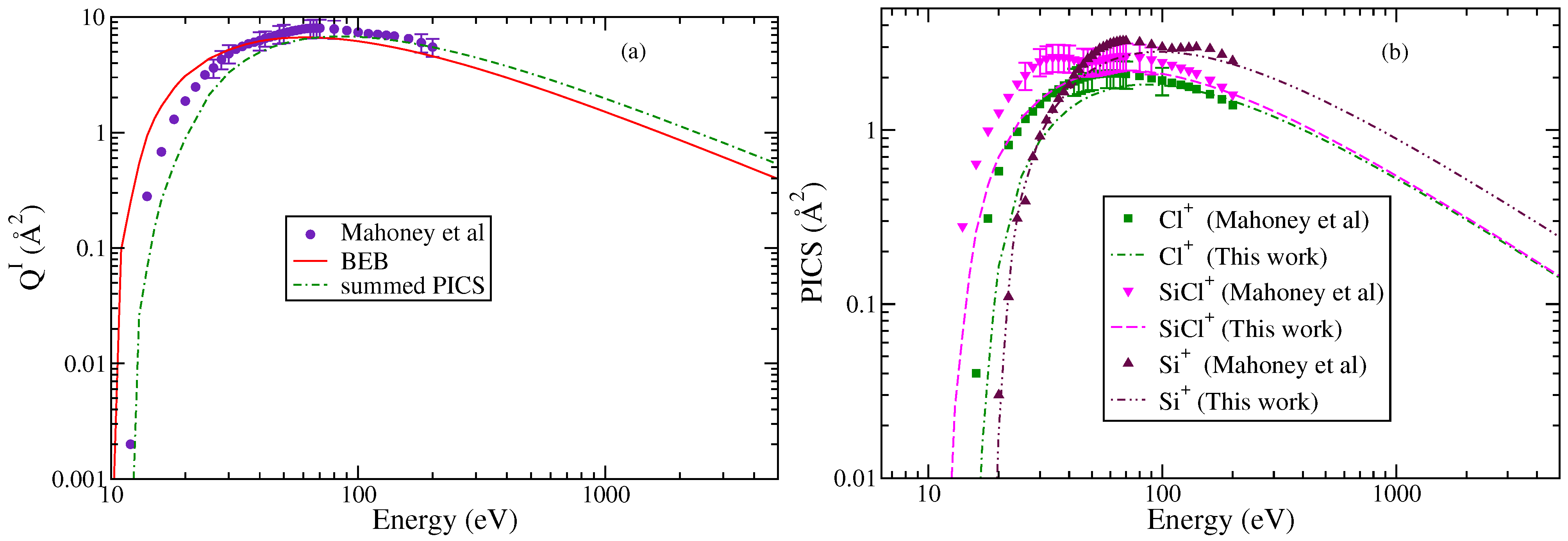
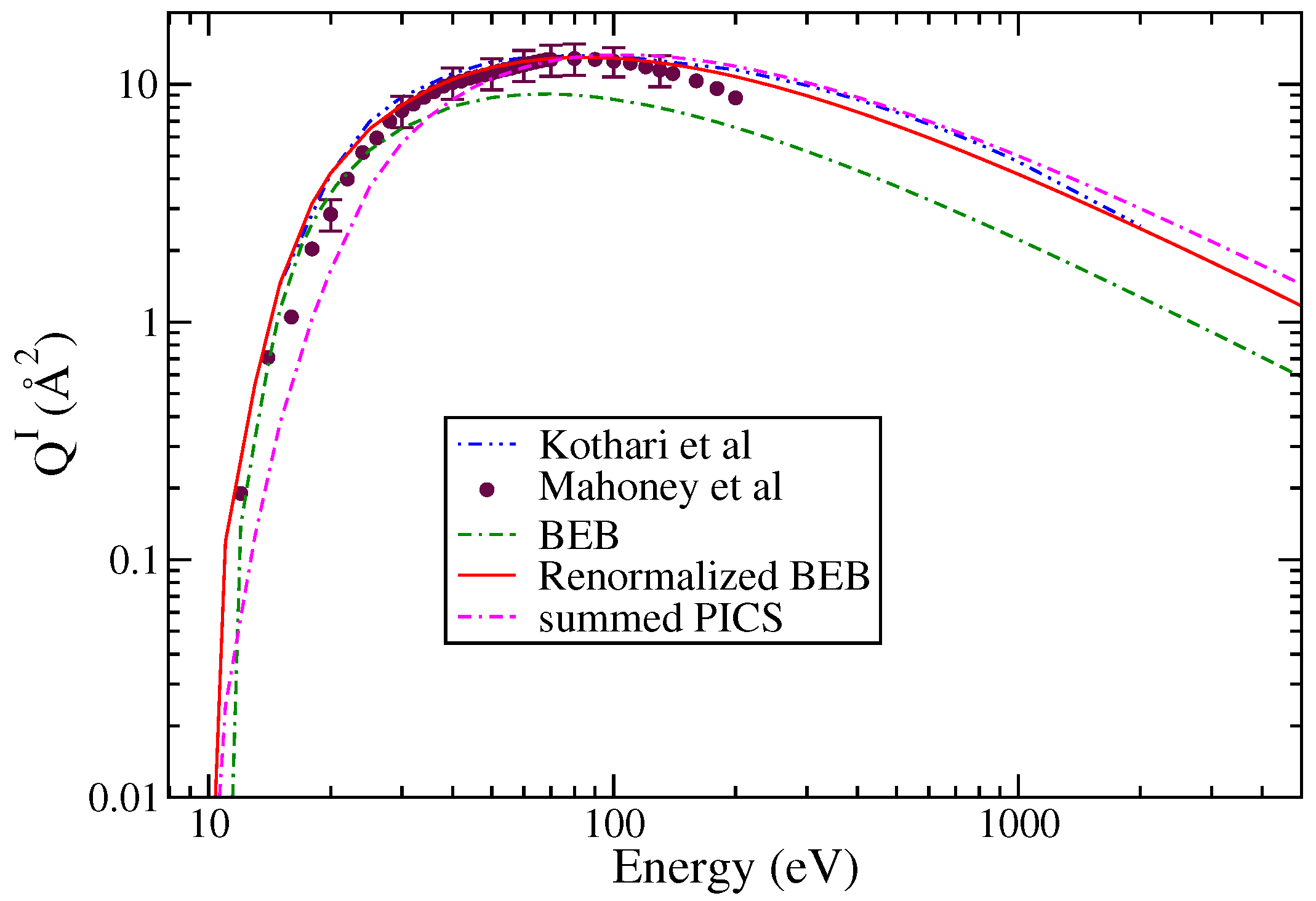
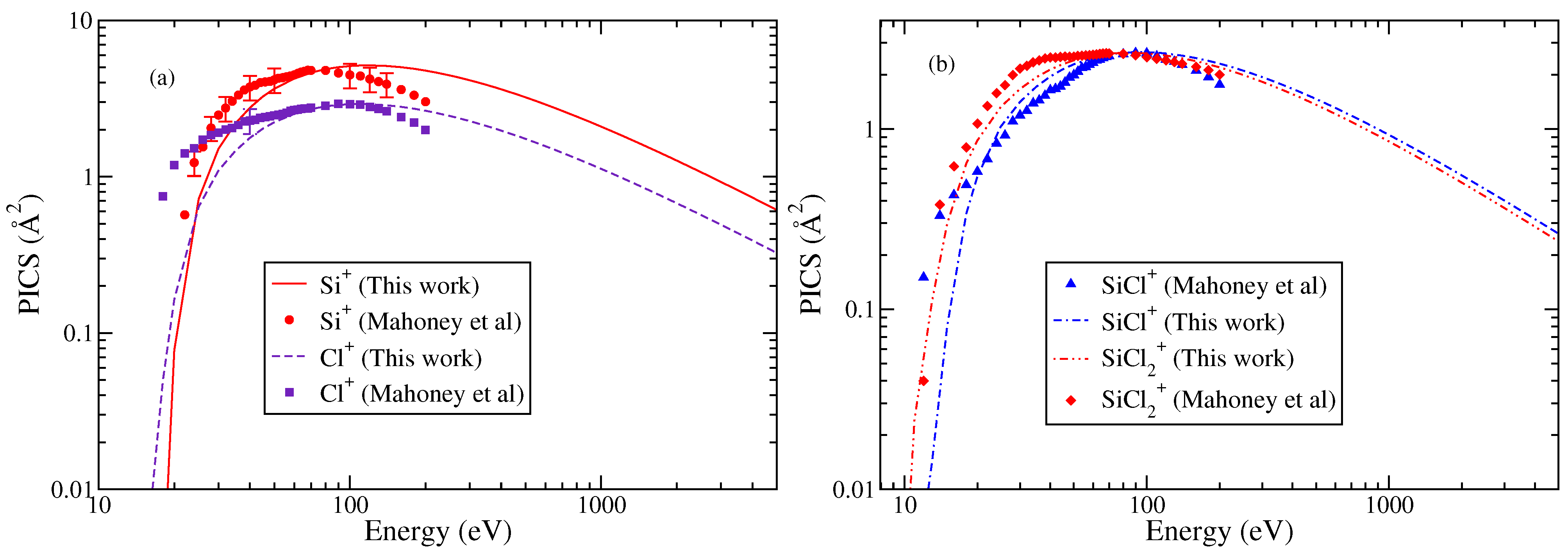
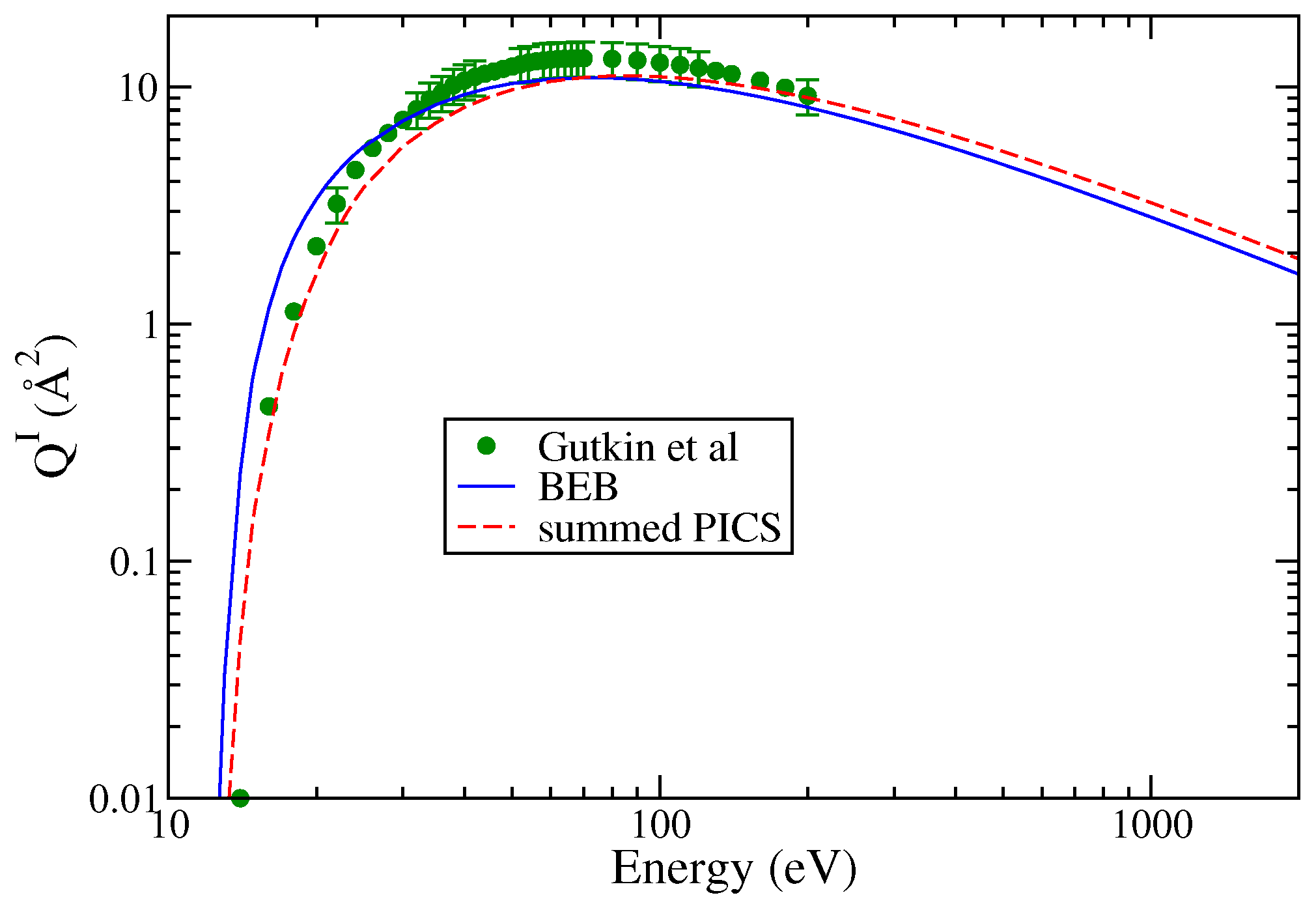
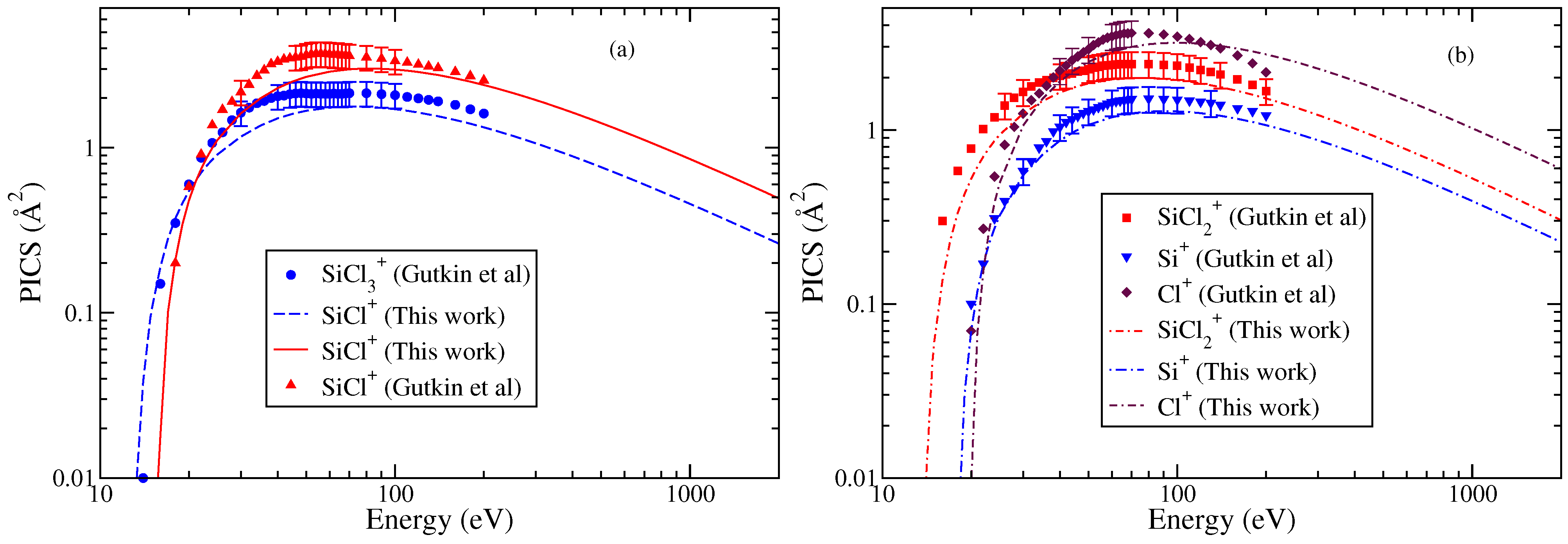
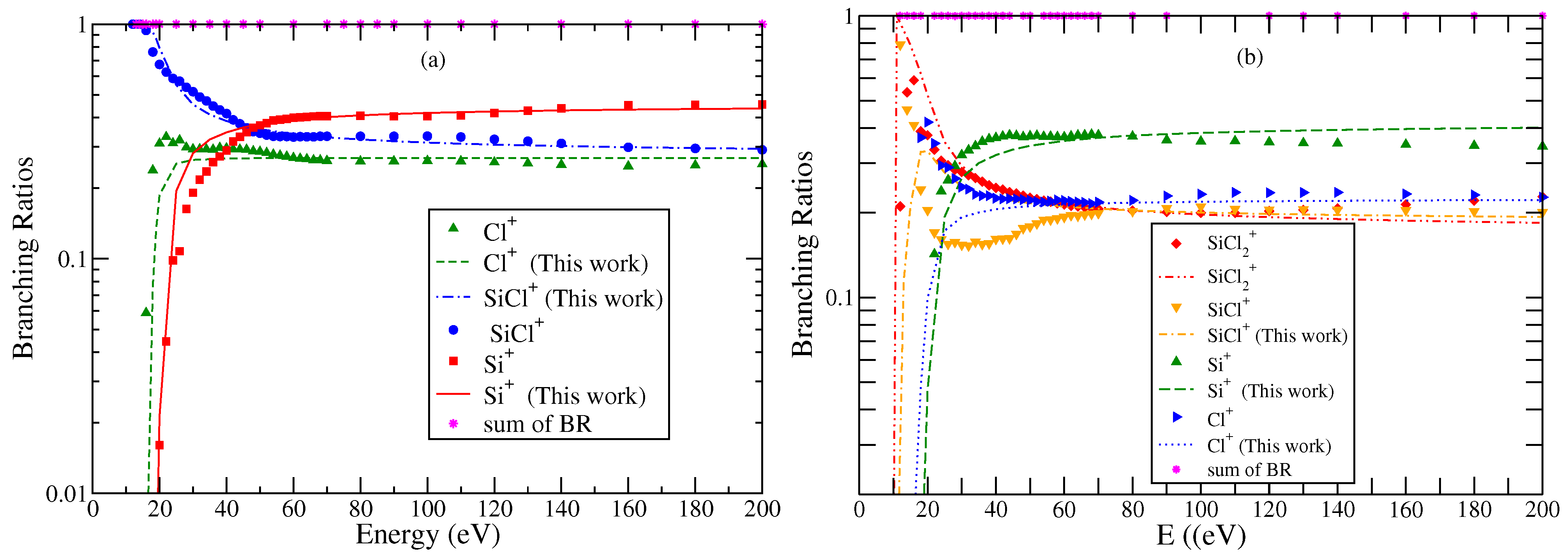
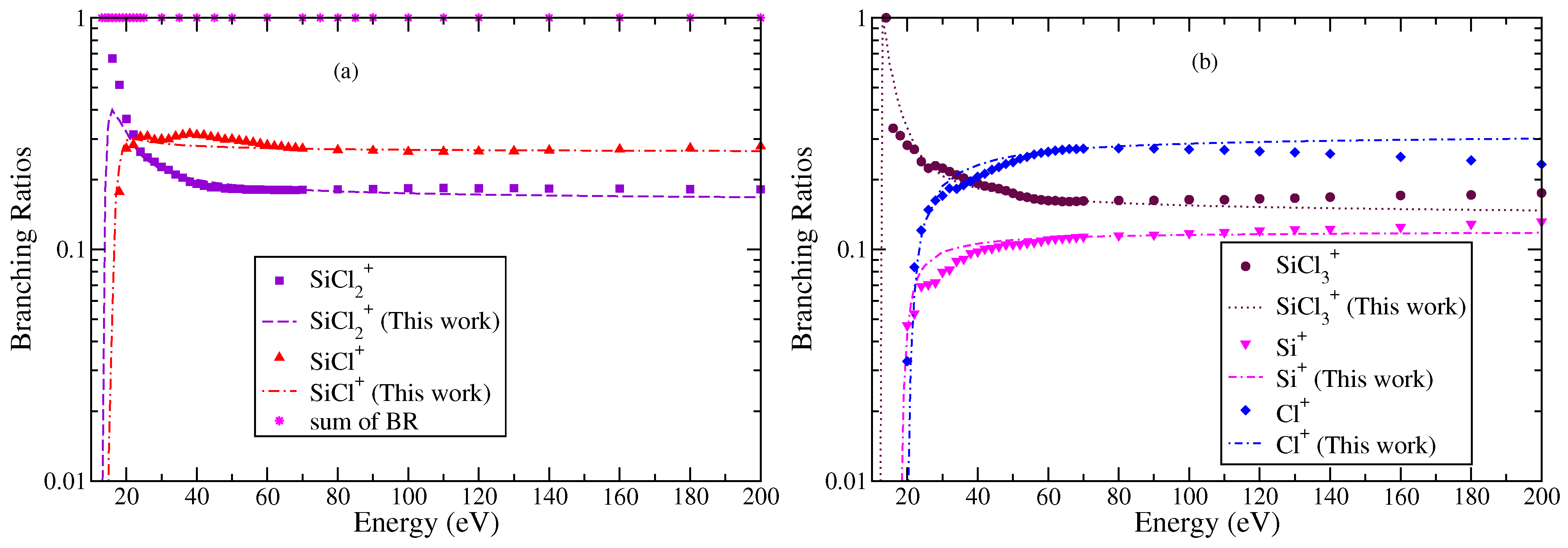
| S. No | Ions | AE | Δ | Γ |
|---|---|---|---|---|
| (eV) | (eV) | |||
| 1. | SiCl+ | 12.0 | 2.0 | 0.4302 |
| 2. | Si+ | 19.0 | 9.0 | 1.108 |
| 3. | Cl+ | 16.0 | 6.0 | 0.530 |
| S. No | Ions | AE | Δ | Γ |
|---|---|---|---|---|
| (eV) | (eV) | |||
| 1. | 10.3 | 0 | 0.3841 | |
| 2. | SiCl+ | 11.0 | 0.7 | 0.4838 |
| 3. | Si+ | 18.0 | 7.7 | 0.8571 |
| 4. | Cl+ | 16.0 | 5.7 | 0.7713 |
| S. No | Ions | AE | Δ | Γ |
|---|---|---|---|---|
| (eV) | (eV) | |||
| 1. | 12.3 | 0 | 0.16187 | |
| 2. | 13.0 | 0.7 | 0.1967 | |
| 3. | SiCl+ | 14.80 | 2.5 | 0.3630 |
| 4. | Si+ | 17.0 | 4.7 | 0.1906 |
| 5. | Cl+ | 19.0 | 6.7 | 0.5602 |
Disclaimer/Publisher’s Note: The statements, opinions and data contained in all publications are solely those of the individual author(s) and contributor(s) and not of MDPI and/or the editor(s). MDPI and/or the editor(s) disclaim responsibility for any injury to people or property resulting from any ideas, methods, instructions or products referred to in the content. |
© 2025 by the authors. Licensee MDPI, Basel, Switzerland. This article is an open access article distributed under the terms and conditions of the Creative Commons Attribution (CC BY) license (https://creativecommons.org/licenses/by/4.0/).
Share and Cite
Kaur, S.; Arora, A.K.; Baluja, K.L.; Bharadvaja, A. Electron Impact Ionization and Partial Ionization Cross Sections of Plasma-Relevant SiClx (x = 1–3) Molecules. Atoms 2025, 13, 64. https://doi.org/10.3390/atoms13070064
Kaur S, Arora AK, Baluja KL, Bharadvaja A. Electron Impact Ionization and Partial Ionization Cross Sections of Plasma-Relevant SiClx (x = 1–3) Molecules. Atoms. 2025; 13(7):64. https://doi.org/10.3390/atoms13070064
Chicago/Turabian StyleKaur, Savinder, Ajay Kumar Arora, Kasturi Lal Baluja, and Anand Bharadvaja. 2025. "Electron Impact Ionization and Partial Ionization Cross Sections of Plasma-Relevant SiClx (x = 1–3) Molecules" Atoms 13, no. 7: 64. https://doi.org/10.3390/atoms13070064
APA StyleKaur, S., Arora, A. K., Baluja, K. L., & Bharadvaja, A. (2025). Electron Impact Ionization and Partial Ionization Cross Sections of Plasma-Relevant SiClx (x = 1–3) Molecules. Atoms, 13(7), 64. https://doi.org/10.3390/atoms13070064






